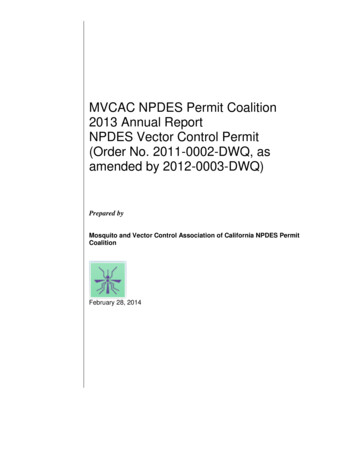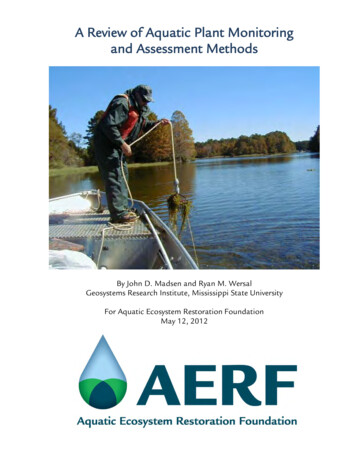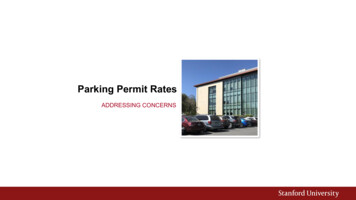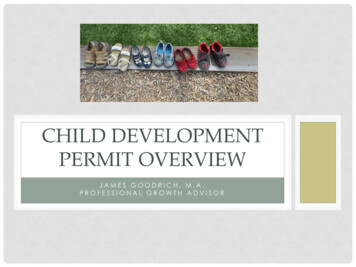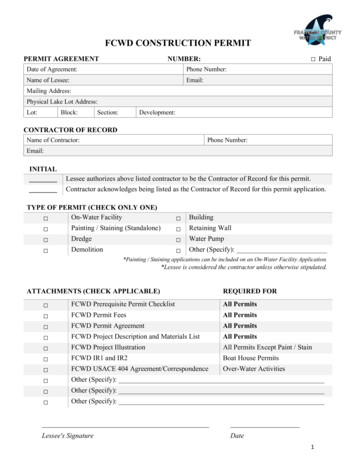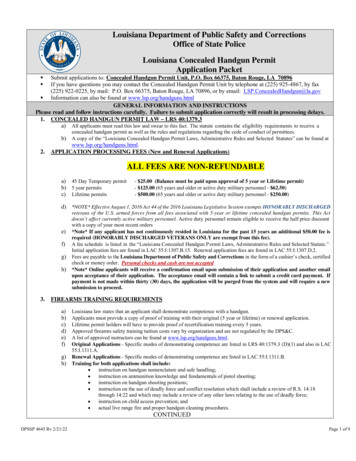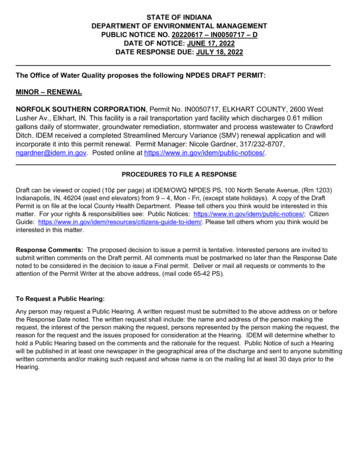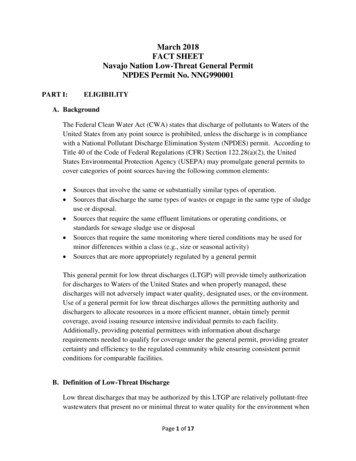
Transcription
March 2018FACT SHEETNavajo Nation Low-Threat General PermitNPDES Permit No. NNG990001PART I:ELIGIBILITYA. BackgroundThe Federal Clean Water Act (CWA) states that discharge of pollutants to Waters of theUnited States from any point source is prohibited, unless the discharge is in compliancewith a National Pollutant Discharge Elimination System (NPDES) permit. According toTitle 40 of the Code of Federal Regulations (CFR) Section 122.28(a)(2), the UnitedStates Environmental Protection Agency (USEPA) may promulgate general permits tocover categories of point sources having the following common elements: Sources that involve the same or substantially similar types of operation.Sources that discharge the same types of wastes or engage in the same type of sludgeuse or disposal.Sources that require the same effluent limitations or operating conditions, orstandards for sewage sludge use or disposalSources that require the same monitoring where tiered conditions may be used forminor differences within a class (e.g., size or seasonal activity)Sources that are more appropriately regulated by a general permitThis general permit for low threat discharges (LTGP) will provide timely authorizationfor discharges to Waters of the United States and when properly managed, thesedischarges will not adversely impact water quality, designated uses, or the environment.Use of a general permit for low threat discharges allows the permitting authority anddischargers to allocate resources in a more efficient manner, obtain timely permitcoverage, avoid issuing resource intensive individual permits to each facility.Additionally, providing potential permittees with information about dischargerequirements needed to qualify for coverage under the general permit, providing greatercertainty and efficiency to the regulated community while ensuring consistent permitconditions for comparable facilities.B. Definition of Low-Threat DischargeLow threat discharges that may be authorized by this LTGP are relatively pollutant-freewastewaters that present no or minimal threat to water quality for the environment whenPage 1 of 17
managed properly. Discharges that are eligible for coverage under the LTGP areintermittent, low volume, and/or short-term in nature. Discharges covered under theLTGP do not contain pollutants in concentrations that cause, have the reasonablepotential to cause, or contribute to an excursion above any applicable water qualitycriterion and are consistent with federal antidegradation policy. Discharges coveredunder this permit should not create environmental damage or nuisance effects.The requirements of the LTGP ensure that discharges are managed such that they poseminimal threat to water quality in receiving waters. The implementation of standardtechnology treatments and/or best management practices (BMPs) are methods tominimize the impact of some discharges, allowing them to qualify for coverage under thisLTGP.C. Eligible DischargesDischarges to Waters of the United States that meet the definition of low threat as definedin section B. above shall be eligible for coverage under the LTGP and may include, butare not limited to, the following categories of discharges: Potable water supply system discharges:o Discharges associated with fire hydrant flushes/testingo Discharges associated with system operation and maintenance activities(wells, pipelines, tanks, reservoirs)o Discharges resulting from potable water filter backwash operationso Discharges associated with system repairo Discharges from cleaning or flushing of water supply wells, pipelines, tanksand reservoirso Discharges from hydrostatic testing of pipelines, tanks, and reservoirso Discharges resulting from initial system startup and routine startupo Discharges resulting from sampling of influent flow, pressure releases, etc.Hydrostatic testing of newly constructed pipelines, tanks, and reservoirs used forpurposes other than pertaining to a potable water systemConstruction dewatering of water where sediment and naturally occurring parameters(e.g. metals, salts, or other physical parameters such as pH, temperature, etc.) in theground water are the only pollutants of concernGroundwater discharges (not for or from remediation)o Pump/well testingo Well development watero Dewatering dischargesOther discharges that meet the definition of low-threat as determined by EPAPage 2 of 17
Eligible discharges of water supply systems or other potable water will be free frompollutants of concern except for chlorine and chlorine by-products and will meet federalMaximum Contaminant Levels (MCLs). Eligible groundwater discharges will be freefrom pollutants of concern except for sediment and naturally occurring parameters.Some wastewaters, although not contaminated, have the potential to cause undesirabledischarge effect due to high flow or volume; in such cases, the discharge becomes lowthreat when proper management controls are designed and implemented to avoidenvironmental effects.In order to be covered under the LTGP the applicant will identify any contaminants ofconcern (naturally occurring or otherwise) that are believed to be present in the dischargeand to describe the treatment and BMPs that will be used to ensure that the dischargedoes not cause a violation of the effluent limits or other specified requirements in thepermit, or cause effects detrimental to the receiving water body or surroundingenvironment that are in violation of this LTGP.D. Ineligible DischargesDischarges that EPA does not consider low-threat for the purposes of this LTGP includebut are not limited to: Discharges containing domestic wastewaterDischarges resulting from non-potable water filter backwash operations;Discharges near or adjacent hazardous waste sites, soil or groundwater remediationsites, or where discharge activities may encounter polluting constituents ingroundwater that are naturally occurring in these watersDischarge from mining activitiesDischarges from leaking chemical and fuel tanksDischarges of industrial wasteDischarges that would require extensive biological or chemical treatment in order tomeet effluent limits or relevant water quality standardsDischarges of non-contact cooling waterDischarges of ongoing operation of permanent domestic or industrial water orwastewater treatments plants or industrial processesDischarges that are uncharacterized or insufficiently characterized to establishsuitability for coverage as low-threatDischarges containing additives associated with water treatment or industrial use(other than chlorine for potable water use)Page 3 of 17
Discharges of groundwater, surface water, or potable water associated with the ongoing testing of pipes, tanks or vessels that have been used to store or transportpetroleum, natural gas, or any other substance other than potable waterDischarge of accidental or unplanned releases from any sourceDischarge of wastewater with pollutants of concern other than those for whicheffluent limits are specified in this LTGPAny other discharges that do not meet the definition of low-threat as determined bythe Regional Administrator pursuant to this LTGPE. Geographic Coverage of PermitThis permit provides coverage for low threat discharges that occur in the Navajo Nationincluding Navajo Nation Reservation lands in New Mexico and Utah where EPA RegionIX is the NPDES permitting authority. A map of the lands covered by this permit isattached as an appendix to the permit for ease of determination of geographic coverage ofthe permit.For such discharges in Region IX under the NPDES permitting jurisdiction of a State butoutside the areas of coverage above, the State NPDES permitting authority must becontacted to provide coverage under a State-issued NPDES low threat or de minimispermit or under a State-issued individual permit.PART II:AUTHORIZATION REQUIREMENTSA. Category of Discharge:Discharges that meet the requirement for eligibility pursuant to PART I. C. above and fallinto one the following categories are authorized for coverage under the LTGP1. Category IA discharge form a single outfall of 0.10 MGD or less, ANDA discharge of 30 days or less.2. Category IIa. A discharge from a single or multiple outfalls of 0.50 MGD or less(cumulative if multiple outfalls), ANDA discharge of 30 days or less.Page 4 of 17
b. A discharge from a single or multiple outfalls of 0.05 MGD or less, ANDA discharge of 30 days or more (continuous or intermittent).B. Application Requirements:1. Notice of Intent (NOI)In order to apply for coverage under this LTGP the applicant in either Category I orCategory II must submit a Notice of Intent (NOI) letter and provide all of thesupplemental information that it requires pursuant to 40 CFR Section 122.28(b). Therequirements are also described in the LTGP itself. In particular the applicant mustprovide facility information, discharge information, receiving water information, anddata that are representative of the discharge. For all discharge types, the applicantmust certify that the discharge complies with screening criteria that are described inthe LTGP permit. For instance the applicant must certify that the discharge containsno known contaminants of concern (COCs). For potable water related discharges, theapplicant must also certify that the discharge meets federal Maximum ContaminantLevels (MCLs). See below for the screening requirements of Category I andCategory II dischargers.Table 1. NOI Screening for Category I dischargesParameterUnitsScreening ValueNotesTotal Residual Chlorineµg/L(1)pHS.U.11 (4-day average)19 (1-hour average)within the range 6.0 to 9.0TurbidityNTUs50Electrical conductivity @ 25 Cμmhos/cmDissolved Oxygenmg/LNo less than 5Constituents with MCLs--COCs and water treatmentadditives--ColorOdor--The discharge meets MCLsfor all constituentsThe discharge has no knownCOCs and does not containadditives apart from chlorine.not objectionablePage 5 of 17(2)(2)(3)
Floating solidsSettled solidsSuspended solidsFoamOther indicators of pollutionOil sheen--no pollutants present to settleto form objectionabledeposits; float as debris,scum, oil, or other matterforming nuisancesAbsentTotal Suspended Solidsmg/L(3)(3)30 (30-day average)45 (7-day average)1. For chlorinated discharges. If discharge does not meet the chlorine discharge limit,the NOI must provide the method of de-chlorination that will be used to meet thelimit.2. Based on data3. Based on visual inspectionNOI Screening for Category II dischargersIn addition to the screening requirements for Category I dischargers, Category IIdischargers must conduct a priority pollutant scan to determine whether there isreasonable potential for discharge of pollutants considered to be of principal importancefor control under the CWA; a list of these pollutants is provided as Appendix A to 40CFR Part 423.For Category I discharges, the complete NOI must be submitted a minimum of 14 daysbefore commencing the planned discharge; for Category II discharges, the complete NOImust be submitted a minimum of 30 days before commencing the planned discharge.C. Best Management Practices Plan (BMPP)Pursuant to 40 CFR Section 122.2, Best Management Practices (BMPs) means schedulesof activities, prohibitions of practices, maintenance procedures, and other managementpractices to prevent or reduce the pollution of “waters of the United States.” BMPs mayinclude, but are not limited to, treatment requirements, operating procedures, or practicesto control plant site runoff, spillage, etc. In the context of the LTGP such BMPsprimarily include but are not limited to flexible practices or procedures that can be usedto prevent pollutants from entering receiving waters or other effects such as erosion andflooding.Page 6 of 17
The Best Management Practices Plan (BMPP) must describe the BMPs that will beimplemented to ensure that the discharges proposed for coverage under this LTGP do notthreaten receiving water quality. The BMPP must be prepared before or concurrentlywith when the NOI letter is submitted to EPA for permit coverage. The requirements forthe BMPP for all discharges as well as specific requirements for particular categories orclasses of discharges (e.g. hydrostatic test discharges) are specified in the LTGP.D. Authorization and Termination1. AuthorizationApplicants must submit a complete NOI letter requesting coverage at least fourteen (14)or at least thirty (30) days before the expected start of discharge based on the Category ofDischarge as provided in Table 2. belowTable 2: NOI Submittal Deadlines/Discharge Authorization DatesCategoryNOI SubmissionDischargeDeadlineAuthorization Date1Category I:As soon as possible14 days after receipt of- discharges of 0.10 MGD but 14 days beforethe application fromor less from a singlecommencing planned EPA, unless EPAoutfall ANDdischarge.contacts the applicant to- 30 days or less duration.deny coverage or requestadditional information.Category IIa:A minimum of30 days after receipt of- discharges of 0.50 MGD 30days prior tothe application fromor less from a single orcommencing planned EPA, unless EPAmultiple outfalls ANDdischarge.contacts the applicant to- 30 days or less duration.deny coverage or requestadditional information.Category IIb:A minimum of 3030 days after receipt of- discharges of 0.05 MGD days prior tothe application fromor less from a single orcommencing planned EPA, unless EPA deniesmultiple outfalls ANDdischarge.coverage or requests- 30 days or moreadditional information.2duration.11.The duration of permit coverage shall not exceed the life of the Permit. The applicant shallreapply for coverage when the Permit is renewed.2.Based upon review of the NOI or other information, EPA may delay authorization for furtherreview, notify the applicant that additional effluent limitations are necessary, or may denycoverage under this permit and require submission of an application for an individual NPDESpermit. In these instances, EPA will notify the applicant (in writing) of the delay, of the needPage 7 of 17
for additional effluent limits, or of the request for submission of an individual NPDES permitapplication.2. TerminationCoverage terminates automatically 31 days after the commencement of discharge forfacilities that obtained coverage under Category I. and II.a. To terminate permit coverage,under Category II.b. an operator must submit a complete and accurate Notice ofTermination (NOT). Information required to be included in a NOT is provided in theLTGP. Authorization to discharge under the LTGP terminates at midnight of the day thata complete NOT is processed and the permittee or operator seeking termination isnotified. The NOT for the facility will also be duly posted on EPA Region IX’s NPDESPermits webpage.Page 8 of 17
PART III:EFFLUENT LIMITATIONSA. Technology-Based Effluent LimitsThere are two approaches for developing technology-based effluent limits for industrialfacilities: (1) using national effluent limitations guidelines (ELGs) and (2) using BestProfessional Judgment (BPJ) on a case-by-case basis (in the absence of ELGs). Theintent of a technology-based effluent limitation is to require a minimum level oftreatment for point sources based on currently available treatment technologies whileallowing the discharger to use any available control technique to meet the limitations.Since industrial discharges and discharges from wastewater treatment plants are noteligible to be covered under this LTGP, no ELGs or secondary standards were availableto develop technology based effluent limitations. Instead, BPJ was used to derivetechnology-based effluent limitations proposed in this permit.Discharges that are eligible for coverage under this LTGP are considered high-qualitywastewaters that are relatively pollutant-free and pose no or minimal threat to waterquality. Technology-based effluent limitations were established for two categories oflow-threat discharges that are anticipated: potable water discharges and ground waterdischarges.EPA anticipates that the wastewater from potable water discharges will not containcontaminants at concentrations of concern apart from residual chlorine or solids that mayhave settled in the distribution system. Effluent limitations for potable water dischargeswere established for chlorine, oil and grease, turbidity, settleable solids, suspended solids,and pH. Additionally, the discharge must meet federal MCLs.Wastewater from ground water discharges covered under this LTGP will not containcontaminants apart from naturally-occurring parameters, including sediments, dissolvedsolids, and turbidity. Effluent limitations for ground water discharges were establishedfor oil and grease, turbidity, settleable solids, dissolved solids, suspended solids, and pH.Flow is limited for all discharges such that no single discharge event shall exceed 0.50MGD over a period of 30 days or less (of continuous flow), or over 0.05 MGD over aperiod of 30 days or more (of continuous flow, or intermittent flow). Flow must bemonitored during each discharge event.Page 9 of 17
B. Water-Quality Based Effluent LimitsCWA section 301(b)(1)(C) requires that permits include any effluent limitationsnecessary to meet water quality standards. Such water quality standards in the case ofthis permit includes the current Navajo Nation Water Quality Standards which have beenapproved by EPA, as well as federal water quality standards that EPA may consider on abest professional judgment basis. With few exceptions (e.g. chlorine), discharges that areeligible for coverage under this LTGP do not contain pollutants in concentrations thatcause, have the reasonable potential to cause, or contribute to an excursion above anyapplicable water quality standard. EPA expects that compliance with other conditions inthis permit (e.g. the technology-based limitations, best management practices, narrativelimitations, etc.) will result in discharges that meet applicable water quality standards;there are no specific water quality-based limitations (WQBELs) in this LTGP. However,EPA may impose additional, more stringent WQBELs, on a site-specific basis ifinformation suggests that the discharge is not controlled sufficiently to meet applicablewater quality standards.C. Narrative LimitsStandard narrative limitations based on the Navajo Nation Surface Water QualityStandards are included in the LTGP.D. Standard Permit ConditionsStandard permit conditions pursuant to 40 CFR Section 122.41 applicable to all permitsissued by EPA Region IX are included in the LTGP.PART IV:MONITORING AND REPORTING REQUIREMENTSThe monitoring and reporting requirements required under the LTGP are for those parametersthat are most likely to be of concern in discharges that qualify as low-threat as defined in Part I.B. above, and therefore likely to be found in discharges from entities seeking coverage under thisGeneral Permit.The individual limitations and monitoring requirements in the LTGP are listed in Table 3.Below:Page 10 of 17
Table 3. Effluent Limitations and Monitoring Requirements for all Low-threat DischargeActivities.ParameterUnitsDaily Max./Min. FrequencyNotesMeteredContinuous(4), (5) (6)(5)ALL DISCHARGESFlowMGDReport(MGD)pHSUmust remain within 6.0 e(7)Oil OUNDWATER ity@ 25 C)μmhos/cm(9)Discrete(7)(5)(7)(5), (10)POTABLE WATER DISCHARGESTotalResidualChlorineµg/L19111. Average monthly limit applies to Category II discharges, regardless of whether the duration ofdischarge reaches 30 days. The permittee shall report exceedances of any limits for each parameterregardless of monitoring frequency. For example, monthly limits shall be met even when onlymonitoring once per month. The permittee may monitor more frequently than required for anyparameter.2. Samples must be collected at a point immediately following discharge from the vessel and prior tocommingling with storm water, wastewater, or other flows. For Category I discharges that extendPage 11 of 17
3.4.5.6.beyond one hour duration, a second sample shall be collected from the last 10% of the effluent. TheDischarger must confirm that the EL is met before discharge for field-tested parameters.For hydrostatic testing, grab samples shall be taken of the hydrostatic test water being discharged asit leaves the equipment, piping, or vessels being tested at the beginning and at the end of thedischarge and two times during the discharge at evenly spaced time intervals. Each grab sampleshall be tested individually, and the highest result reported.The flow must be below the threshold established for each particular Category of discharger asdescribed in Part II. A of the permitField-testing is permitted, using suitable methods, for flow, pH, total residual chlorine, and electricalconductivity. The permittee shall cease discharge if any of the field-tested parameters exceeds theeffluent limitation.Monitor and report only, no numeric effluent limitation. Where no numeric limit is listed, thenarrative standards in Part III.2.3 of this permit still apply. The permittee must implement BMPs tocontrol the discharge of these constituents, as appropriate, when they are known or suspected to bepresent in the discharge.7. Minimum monitoring frequency of once/discharge Category I. and II. a. ; once/monthCategory II b.8. Oils, greases, waxes, floating material shall not create a nuisance or adversely affect beneficial uses.9. Total Dissolved Solids may be measured indirectly by measuring electrical conductivity. No limitset but monitoring and reporting required.10. The dechlorination method must be disclosed in the NOI.The Rationale for specific limits provided in the table above are as follows:Flow:The flow must be below the threshold for the particular Category as described in Part II. A.above that the permittee is seeking coverage under in this LTGP. A permittee seeking coverageunder Category I. shall not exceed a maximum flow of 0.1 MGD or 100,000 gallons per dayfrom the permitted outfall. A permittee seeking coverage under Category II. a. shall not exceed amaximum cumulative flow of 0.5 MGD or 500,000 gallons per day from the permitted outfall oroutfalls. A permittee seeking coverage under Category II. b. shall not exceed a maximumcumulative flow of 0.05 MGD or 50,000 gallons per day from the permitted outfall or outfalls.pHThe limit of between 6.0 and 9.0 standard units is based on the minimum secondary treatmentstandards for wastewater established under 40 CFR Section 122.45Total Suspended Solids (TSS)The TSS daily maximum limit of 45 milligrams per liter and the monthly average limit of 30milligrams per liter are based on minimum secondary treatment standards for wastewaterestablished under 40 CFR 133.102(b)Page 12 of 17
Oil and GreaseNo numeric limits have been established, but the permittee must meet the narrative requirementthat the effluent not have oils, greases, waxes, floating material in amounts that create a nuisance oradversely affect beneficial uses.TurbidityThe turbidity daily maximum limit of 50 NTUs and monthly average limit of 10 NTUs is basedon best professional judgment (BPJ) taking into account the CWA 304(a) NationalRecommended Water Quality Criteria, which defer to the narrative statement found in the RedBook Quality Criteria for Water, 1976.Total Dissolved Solids (TDS)No numeric limits have been established, but the permittee must meet the narrative standardsrequirement that the discharge not produce objectionable color, odor, taste or turbidity; orproduce adverse physiological responses in humans, animals or plants.Total Residual Chlorine (TRC)The TRC daily maximum limit of 19 micrograms per liter and the monthly average limit of 11micrograms per liter are based on the Navajo Nation Surface Water Quality Standards.PART V: ESA AND NHPAA. Endangered Species ActSection 7 of the Endangered Species Act (ESA) of 1973 (16 U.S.C. § 1536) requiresfederal agencies to ensure that any action authorized, funded, or carried out by the federalagency does not jeopardize the continued existence of a federally listed or candidatespecies, or result in the destruction or adverse modification of its habitat.The scope of the action authorized by the EPA pursuant to this proposed NPDES permitis to allow discharge from wastewater sources that are classified as low-threat sources.Low-threat discharges are clean or relatively pollutant-free wastewaters that present no orminimal threat to water quality for the environment when managed properly. Dischargesthat are eligible for coverage under the LTGP are generally intermittent, low volume,and/or short-term in nature and do not contain pollutants in concentrations that cause,have the reasonable potential to cause, or contribute to an excursion above any applicablewater quality criterion. Discharges covered under this LTGP pose minimal threat towater quality in receiving waters, and so are unlikely to jeopardize the continuedexistence of a federally listed or candidate species, or result in the destruction or adversePage 13 of 17
modification of its habitat. However, since the specific geographic locations of facilitiescovered under the LTGP is currently unknown, each applicant must submit informationregarding federally listed or candidate endangered species, and protected habitat found inthe vicinity of the applicant’s proposed discharge location. The procedure for eachapplicant to follow to comply with the requirements of the ESA are detailed inAttachment C. of the permit.B. National Historic Preservation ActSection 106 of the National Historic Preservation Act (NHPA) requires federal agenciesto consider the effect of their undertakings on historic properties that are either listed on,or eligible for listing on, the National Register of Historic Places.The scope of the action authorized by the EPA pursuant to this proposed NPDES permitis to allow discharge from wastewater sources that are classified as low-threat sources.Low-threat discharges are clean or relatively pollutant-free wastewaters that present no orminimal threat to water quality for the environment when managed properly. Since thespecific geographic locations of facilities covered under the LTGP is unknown, eachapplicant must submit information regarding historic properties that are listed on oreligible for listing on, the National Register of Historic Place found in the vicinity of theapplicant’s proposed discharge location, for the USEPA and the appropriate StateHistoric Preservation Officer (SHPO) or Tribal Historic Preservation Officer (THPO) toevaluate. The procedure for each applicant to follow to comply with the requirements ofthe NHPA are detailed in Attachment D. of the permitPART VI: OTHER CONSIDERATIONS UNDER FEDERAL LAWA. AntidegradationEPA’s antidegradation policy at 40 CFR Section 131.12 requires existing water uses andthe level of water quality necessary to protect the existing uses to be maintained.Due to the nature of the discharge activities, management practices that ensure clean orrelatively pollutant-free wastewaters, and the effluent limitations designed to becomparable to wastewater that has received a high level of treatment, it is not expectedthat the discharge will adversely affect the receiving water.B. Anti-BackslidingSection 402(o) of the CWA prohibits the renewal or reissuance of an NPDES permit thatcontains effluent limits less stringent than those established in the previous permit, exceptPage 14 of 17
as provided in the statute. The LTGP permit is not a renewal and therefore does notallow backsliding.C. Environmental JusticeEPA has conducted a screening level evaluation of the potential impact of this permitusing EPA’s EJSCREEN tool. As the exact location of potential facilities that may beauthorized pursuant to this permit is indeterminate, EPA instead evaluated the evaluateddemographic characteristics of the population of the Navajo Nation, which indicated thatthe population may be at relatively higher risk if exposed to environmental contaminantsthan the national population. Demographic characteristics that showed potentiallysensitive scores were a high proportion of minority and low-income population andpopulation with less than high school education.EPA concludes that the facilities authorized to discharge pursuant to this permit areunlikely to contribute to any EJ issues, as permit coverage is restricted to facilities thatdischarge relatively pollutant-free wastewaters that are intermittent, low volume, and/orshort-term in nature and present no or minimal threat to water quality for the environmentwhen managed properly. EPA believes that implementing the limits established in thispermit which require compliance with the provisions of the Clean Water Act, aredesigned to ensure full protection of human health and the environment and ensure thatthe discharges will not cause or contribute to human health risk in the vicinity of thefacilities covered by the permit.D. Water Quality Certification RequirementsPursuant to 40 CFR sections 124.53 and 124.54 USEPA is requesting certification fromthe Navajo Nation, that the proposed permit will meet all applicable water qualitystandards.Page 15 of 17
PART VII:ADMINISTRATIVE INFORMATIONA. Administrative RecordThe Administrative Record for the LTGP and any additional information related to thisproposed permit is available at:U.S. Environmental Protection Agency, Region IXCWA Standards & Permits Office Mail Code: WTR-575 Hawthorne StreetSan Francisco, California 94105Telephone: (415)972-3516Attn: Gary ShethB. Public Notice and Comment/Public HearingPursuant to 40 CFR section 124.10 the public notice is the vehicle for informing allinterested parties and members of the general public of the contends of a draft NPDESpermit or
Navajo Nation Low-Threat General Permit NPDES Permit No. NNG990001 PART I: ELIGIBILITY A. Background The Federal Clean Water Act (CWA) states that discharge of pollutants to Waters of the United States from any point source is prohibited, unless the discharge is in compliance with a National Pollutant Discharge Elimination System (NPDES) permit
